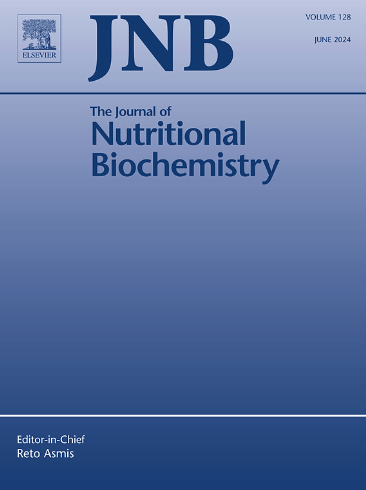Fucoxanthin ameliorates vascular remodeling via attenuating oxidative stress in hypoxic pulmonary hypertension rats
IF 4.8
2区 医学
Q1 BIOCHEMISTRY & MOLECULAR BIOLOGY
引用次数: 0
Abstract
Hypoxic pulmonary hypertension (HPH) is a fatal cardiopulmonary disease characterized by pulmonary vascular remodeling, primarily resulting from abnormal proliferation of pulmonary artery smooth muscle cells (PASMCs). Fucoxanthin, a natural carotenoid with potent antioxidant activity, was investigated for its therapeutic potential in HPH, given the critical role of oxidative stress in disease pathogenesis. In this study, Sprague–Dawley rats were exposed to intermittent chronic hypoxia for 4 weeks to mimic severe HPH. The results demonstrated that fucoxanthin significantly reduced the elevated right ventricular systolic pressure (RVSP), alleviated right ventricular hypertrophy, and mitigated pulmonary artery remodeling in the HPH rats. Additionally, fucoxanthin enhanced superoxide dismutase (SOD) activity and glutathione (GSH)/glutathione disulfide (GSSG) ratio while decreasing malondialdehyde (MDA) levels in both lung tissues and serum of HPH rats. In vitro, fucoxanthin inhibited cell proliferation and migration, decreased reactive oxygen species (ROS) production in hypoxia-induced PASMCs, and improved cell viability in hypoxia-induced endothelial cells (ECs). Importantly, fucoxanthin reduced hypoxia-inducible factor 1 alpha (HIF-1α) expression in both lung tissues and PASMCs under hypoxia. Notably, fucoxanthin exhibited effects similar to those of 2-methoxyestradiol (2ME2), an inhibitor of HIF-1α, on cell proliferation and ROS production in hypoxia-induced PASMCs. Moreover, fucoxanthin treatment did not significantly alter HIF-1α expression, cell proliferation, or ROS production after 2ME2 blocked HIF-1α. Collectively, fucoxanthin suppressed hypoxia-induced oxidative stress primarily by regulating the HIF-1α-ROS pathway, thereby alleviating pulmonary remodeling in HPH. Our findings represent a promising therapeutic strategy for HPH by improving pulmonary vascular remodeling.
岩藻黄素通过减轻缺氧肺动脉高压大鼠氧化应激改善血管重构。
低氧性肺动脉高压(HPH)是一种以肺血管重构为特征的致命性心肺疾病,主要由肺动脉平滑肌细胞(PASMCs)异常增殖引起。岩藻黄质是一种具有强抗氧化活性的天然类胡萝卜素,鉴于氧化应激在疾病发病机制中的关键作用,研究了其在HPH中的治疗潜力。在这项研究中,Sprague-Dawley大鼠暴露于间歇性慢性缺氧4周,以模拟严重HPH。结果表明,岩藻黄素能显著降低HPH大鼠右心室收缩压升高,减轻右心室肥厚,减轻肺动脉重构。岩藻黄素提高了HPH大鼠肺组织和血清中超氧化物歧化酶(SOD)活性和谷胱甘肽(GSH)/谷胱甘肽二硫(GSSG)比值,降低了丙二醛(MDA)水平。在体外,岩藻黄素抑制了缺氧诱导的PASMCs细胞的增殖和迁移,降低了活性氧(ROS)的产生,提高了缺氧诱导的内皮细胞(ECs)的细胞活力。重要的是,岩藻黄素降低了缺氧条件下肺组织和pasmc中缺氧诱导因子1α (HIF-1α)的表达。值得注意的是,岩藻黄素对缺氧诱导的PASMCs细胞增殖和ROS产生的影响与HIF-1α抑制剂2-甲氧基雌二醇(2ME2)相似。此外,岩藻黄素处理并没有显著改变2ME2阻断HIF-1α后HIF-1α的表达、细胞增殖或ROS的产生。综上所述,岩藻黄素主要通过调节HIF-1α-ROS途径抑制缺氧诱导的氧化应激,从而减轻HPH中的肺重构。我们的研究结果通过改善肺血管重塑为HPH提供了一种有希望的治疗策略。
本文章由计算机程序翻译,如有差异,请以英文原文为准。
求助全文
约1分钟内获得全文
求助全文
来源期刊

Journal of Nutritional Biochemistry
医学-生化与分子生物学
CiteScore
9.50
自引率
3.60%
发文量
237
审稿时长
68 days
期刊介绍:
Devoted to advancements in nutritional sciences, The Journal of Nutritional Biochemistry presents experimental nutrition research as it relates to: biochemistry, molecular biology, toxicology, or physiology.
Rigorous reviews by an international editorial board of distinguished scientists ensure publication of the most current and key research being conducted in nutrition at the cellular, animal and human level. In addition to its monthly features of critical reviews and research articles, The Journal of Nutritional Biochemistry also periodically publishes emerging issues, experimental methods, and other types of articles.
 求助内容:
求助内容: 应助结果提醒方式:
应助结果提醒方式:


